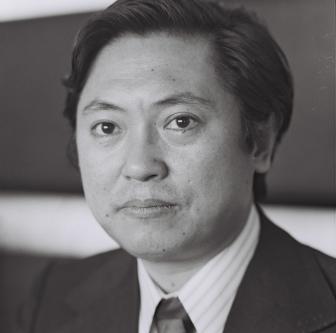Article
Makoto Ooka translation project
‘All about the Wind’ in the Tower of Babel

December 22, 2017
The fifth to seventh lines of the poem are typical of Makoto Ooka: “Stones are given an enema by the stream./ Quivering sphincters of the pebbles./ Quivering anguish of the pebbles’ flesh."
Here is a unique combination of ancient Japanese animism and modern Western surrealism, whose influence Ooka experienced in his younger days. The juxtaposition of the clinical terms with a natural sort of lyricism is also characteristic of Ooka. While some translators enjoyed this contrast and translated these lines literally, others found such terms as ‘enema’ and ‘sphincters’ too raw and replaced them with more general expressions.
For example, Dalibor Klickovic, who translated from the original Japanese to Serbian, finds in these lines a Zen-like beauty: “The ‘organization’ of this poem in which extreme materiality and abstract concepts are combined invites the communion of languages across time and space….which is essential to the poetry of Makoto Ooka”. Norddine Zouitni, who translated Ooka’s poem into Arabic, described these lines as “sensual, visceral, expressing vibrant sensitivity….with a feeling touch of (bitter-sweet) lewdness about them”.
On the other hand, Leanne O'Sullivan in Ireland says she decided “not to use the words ‘enema’, ‘osmosis’ and ‘sphincter’ because they cannot be translated directly into Irish. I would have had to use the English words - and so used a word that means ‘cleanse’ and a word for ‘muscle’ in Irish.”
The most challenging (and fun) part of the translation should be Ooka's use of the Japanese old saying “to make even a mole cricket swim across the river", which Janine Beichman translated as “make the ocean fit into a buttercup”.
Many translators, who are poets themselves, dealt with this challenge in a creative way: Aurélia Lassaque has come up with her own expression, the equivalent of “make the high sea enter in a tear” in Occitan, her mother language. Jan Baeke, a Dutch poet, chose het bijltje erbij neergooien, which means to throw down the axe at a certain point after starting to chop wood firmly or enthusiastically. Jan found that “Given the ‘location’ in the poem, this was a very tempting choice”. In Burmese, the phrase was translated as a “haystack fire that will burn the palace spire”. According to Ko Ko Thett, this line is an expression for “passion that doesn't last long”. Nevin Yeni and Gökçenur Ç., who collaborated for the Turkish translation, chose the expression “passing over the mountains in one step”.
Batsheva Dori-Carlier noted, “I've translated ‘mole cricket’ as grasshopper, for two reasons: the literal, ‘correct’ translation of ‘mole cricket’ is a term which almost no Hebrew reader/speaker is familiar with. In the first version, I wrote the Hebrew word for ‘cricket’, which is a familiar word in Hebrew. Then I preferred the Hebrew word for grasshopper, since in Hebrew entomology it is much closer to the ‘mole cricket’ in spirit and in poetic function, and the association it brings up is the closest to the one expressed in the poem’.
Josep m. Rodríguez, a Catalan poet, used the local saying of “finding the three feet of a cat”. “I don't know the origin, nor do I understand at all (cats have four feet, so finding three should be easy), but that's the way it is”. Gabriel Álvarez Martínez, who is the Spanish translator of Japanese novels including Haruki Murakami's, translated it into Galician. For this expression, he originally tried “looking for acorns by a chestnut tree” but later settled with “show the water in a sieve” based on the Galician expression apañar auga na peneira, which better suits the poem's location in a shallow after the rain.
Abol Froushan, PIW editor for Iran, selected two translators, Saeid Banaie and Mostapha Samady, each of whom provided a translation. When asked to combine the two and make one complete version, Abol asked back:
Would it be possible to combine the two translations to get a closer to the Japanese text? There is always a gap between the poem and its reconstruction in another language, a gap we should not remove, but rather look at it as a point of excess which marks its distinctive quality as a literary event. Does that make sense? The excess is a finger print of the one who has intervened as a poet translator. In the two cases, we can see biases in terms of style, diction, syntax etc. They each depart from a “true representation”, if such a thing exists, in different ways. To join them would be the work of a third point of reference. A third subject working to meld the other two. That in itself inserts a third finger print. What are we doing in translation other than representing a presentation?
Indeed we are. There are all in all seventeen languages/eighteen representations in this presentation of ‘All About the Wind’. Eighteen sets of finger prints on the waves in the air and light, creating countless gaps for viewing. We invite you to get lost in this mesmerizing maze.
How do you understand an assertion about something that would “make even a mole cricket swim across the river”? Our PIW translation project involved this idiom and many other intriguing propositions - originally in Japanese - from a section of the three-part poem ‘Kaze no setsu’ (風の説) by Makoto Ooka (included in Sad Songs and Blessings in 1976). Kaze means wind and setsu an opinion or theory. The title can roughly be translated as “theory of the wind”. Janine Beichman translated it as ‘All About the Wind’ in her Beneath the Sleepless Tossing of the Planets, and Dominique Palme translated it in French as ‘PROPOS SUR LE VENT’. Both translations were used as reference points for this project, an homage to Ooka.
Even the seemingly straightforward title, however, may have some other meaning hidden underneath. Nagi Yoshikawa, who translated this poem directly from Japanese to Korean, noted that the Japanese word 風 (kaze =wind) has the connotation of something unconfirmed or unreliable, and if the original title is shortened to 風説 by skipping the preposition no in the middle, it would denote a rumor. Ooka was obviously being playful here. Furthermore, Nagi pointed out that the Korean word for 風 or param has the double-meaning of to tell a lie and to flirt. She translated the title as Param-i-Hanun Sori, “the opinion that the wind states” and “the sound of the wind”.
Asked if the Chinese 風 has a similar double meaning, Ming Di, who translated the title as 风説 (风 = simplified version of 風), answered “the Chinese 风説 is neutral, no negative connotations. It's interesting because it carries multiple meanings: Wind Speaks, Wind Speaking, Wind Theory, Wind Hypothesis, etc. etc. It is风言风语 that means rumor, or something unconfirmed.”
The fifth to seventh lines of the poem are typical of Makoto Ooka: “Stones are given an enema by the stream./ Quivering sphincters of the pebbles./ Quivering anguish of the pebbles’ flesh."
Here is a unique combination of ancient Japanese animism and modern Western surrealism, whose influence Ooka experienced in his younger days. The juxtaposition of the clinical terms with a natural sort of lyricism is also characteristic of Ooka. While some translators enjoyed this contrast and translated these lines literally, others found such terms as ‘enema’ and ‘sphincters’ too raw and replaced them with more general expressions.
For example, Dalibor Klickovic, who translated from the original Japanese to Serbian, finds in these lines a Zen-like beauty: “The ‘organization’ of this poem in which extreme materiality and abstract concepts are combined invites the communion of languages across time and space….which is essential to the poetry of Makoto Ooka”. Norddine Zouitni, who translated Ooka’s poem into Arabic, described these lines as “sensual, visceral, expressing vibrant sensitivity….with a feeling touch of (bitter-sweet) lewdness about them”.
On the other hand, Leanne O'Sullivan in Ireland says she decided “not to use the words ‘enema’, ‘osmosis’ and ‘sphincter’ because they cannot be translated directly into Irish. I would have had to use the English words - and so used a word that means ‘cleanse’ and a word for ‘muscle’ in Irish.”
The most challenging (and fun) part of the translation should be Ooka's use of the Japanese old saying “to make even a mole cricket swim across the river", which Janine Beichman translated as “make the ocean fit into a buttercup”.
Many translators, who are poets themselves, dealt with this challenge in a creative way: Aurélia Lassaque has come up with her own expression, the equivalent of “make the high sea enter in a tear” in Occitan, her mother language. Jan Baeke, a Dutch poet, chose het bijltje erbij neergooien, which means to throw down the axe at a certain point after starting to chop wood firmly or enthusiastically. Jan found that “Given the ‘location’ in the poem, this was a very tempting choice”. In Burmese, the phrase was translated as a “haystack fire that will burn the palace spire”. According to Ko Ko Thett, this line is an expression for “passion that doesn't last long”. Nevin Yeni and Gökçenur Ç., who collaborated for the Turkish translation, chose the expression “passing over the mountains in one step”.
Batsheva Dori-Carlier noted, “I've translated ‘mole cricket’ as grasshopper, for two reasons: the literal, ‘correct’ translation of ‘mole cricket’ is a term which almost no Hebrew reader/speaker is familiar with. In the first version, I wrote the Hebrew word for ‘cricket’, which is a familiar word in Hebrew. Then I preferred the Hebrew word for grasshopper, since in Hebrew entomology it is much closer to the ‘mole cricket’ in spirit and in poetic function, and the association it brings up is the closest to the one expressed in the poem’.
Josep m. Rodríguez, a Catalan poet, used the local saying of “finding the three feet of a cat”. “I don't know the origin, nor do I understand at all (cats have four feet, so finding three should be easy), but that's the way it is”. Gabriel Álvarez Martínez, who is the Spanish translator of Japanese novels including Haruki Murakami's, translated it into Galician. For this expression, he originally tried “looking for acorns by a chestnut tree” but later settled with “show the water in a sieve” based on the Galician expression apañar auga na peneira, which better suits the poem's location in a shallow after the rain.
Abol Froushan, PIW editor for Iran, selected two translators, Saeid Banaie and Mostapha Samady, each of whom provided a translation. When asked to combine the two and make one complete version, Abol asked back:
Would it be possible to combine the two translations to get a closer to the Japanese text? There is always a gap between the poem and its reconstruction in another language, a gap we should not remove, but rather look at it as a point of excess which marks its distinctive quality as a literary event. Does that make sense? The excess is a finger print of the one who has intervened as a poet translator. In the two cases, we can see biases in terms of style, diction, syntax etc. They each depart from a “true representation”, if such a thing exists, in different ways. To join them would be the work of a third point of reference. A third subject working to meld the other two. That in itself inserts a third finger print. What are we doing in translation other than representing a presentation?
Indeed we are. There are all in all seventeen languages/eighteen representations in this presentation of ‘All About the Wind’. Eighteen sets of finger prints on the waves in the air and light, creating countless gaps for viewing. We invite you to get lost in this mesmerizing maze.
© Yasuhiro Yotsumoto
Sponsors
























